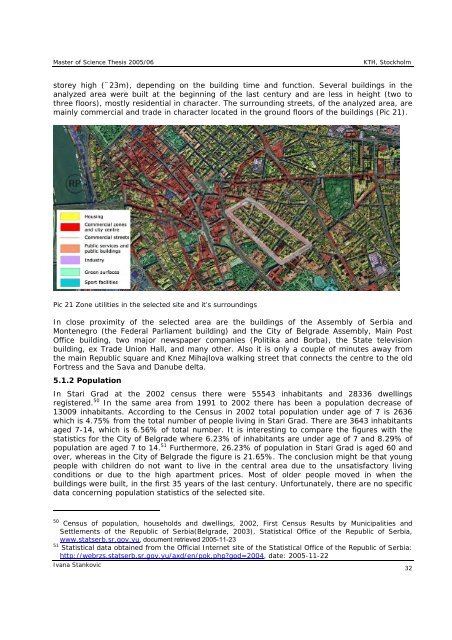Ivana Stankovic
Ivana Stankovic
Ivana Stankovic
Create successful ePaper yourself
Turn your PDF publications into a flip-book with our unique Google optimized e-Paper software.
Master of Science Thesis 2005/06<br />
KTH, Stockholm<br />
storey high (¨23m), depending on the building time and function. Several buildings in the<br />
analyzed area were built at the beginning of the last century and are less in height (two to<br />
three floors), mostly residential in character. The surrounding streets, of the analyzed area, are<br />
mainly commercial and trade in character located in the ground floors of the buildings (Pic 21).<br />
Pic 21 Zone utilities in the selected site and it’s surroundings<br />
In close proximity of the selected area are the buildings of the Assembly of Serbia and<br />
Montenegro (the Federal Parliament building) and the City of Belgrade Assembly, Main Post<br />
Office building, two major newspaper companies (Politika and Borba), the State television<br />
building, ex Trade Union Hall, and many other. Also it is only a couple of minutes away from<br />
the main Republic square and Knez Mihajlova walking street that connects the centre to the old<br />
Fortress and the Sava and Danube delta.<br />
5.1.2 Population<br />
In Stari Grad at the 2002 census there were 55543 inhabitants and 28336 dwellings<br />
registered. 50 In the same area from 1991 to 2002 there has been a population decrease of<br />
13009 inhabitants. According to the Census in 2002 total population under age of 7 is 2636<br />
which is 4.75% from the total number of people living in Stari Grad. There are 3643 inhabitants<br />
aged 7-14, which is 6.56% of total number. It is interesting to compare the figures with the<br />
statistics for the City of Belgrade where 6.23% of inhabitants are under age of 7 and 8.29% of<br />
population are aged 7 to 14. 51 Furthermore, 26.23% of population in Stari Grad is aged 60 and<br />
over, whereas in the City of Belgrade the figure is 21.65%. The conclusion might be that young<br />
people with children do not want to live in the central area due to the unsatisfactory living<br />
conditions or due to the high apartment prices. Most of older people moved in when the<br />
buildings were built, in the first 35 years of the last century. Unfortunately, there are no specific<br />
data concerning population statistics of the selected site.<br />
50 Census of population, households and dwellings, 2002, First Census Results by Municipalities and<br />
Settlements of the Republic of Serbia(Belgrade, 2003), Statistical Office of the Republic of Serbia,<br />
www.statserb.sr.gov.yu, document retrieved 2005-11-23<br />
51 Statistical data obtained from the Official Internet site of the Statistical Office of the Republic of Serbia:<br />
http://webrzs.statserb.sr.gov.yu/axd/en/pok.php?god=2004, date: 2005-11-22<br />
<strong>Ivana</strong> <strong>Stankovic</strong><br />
32
















